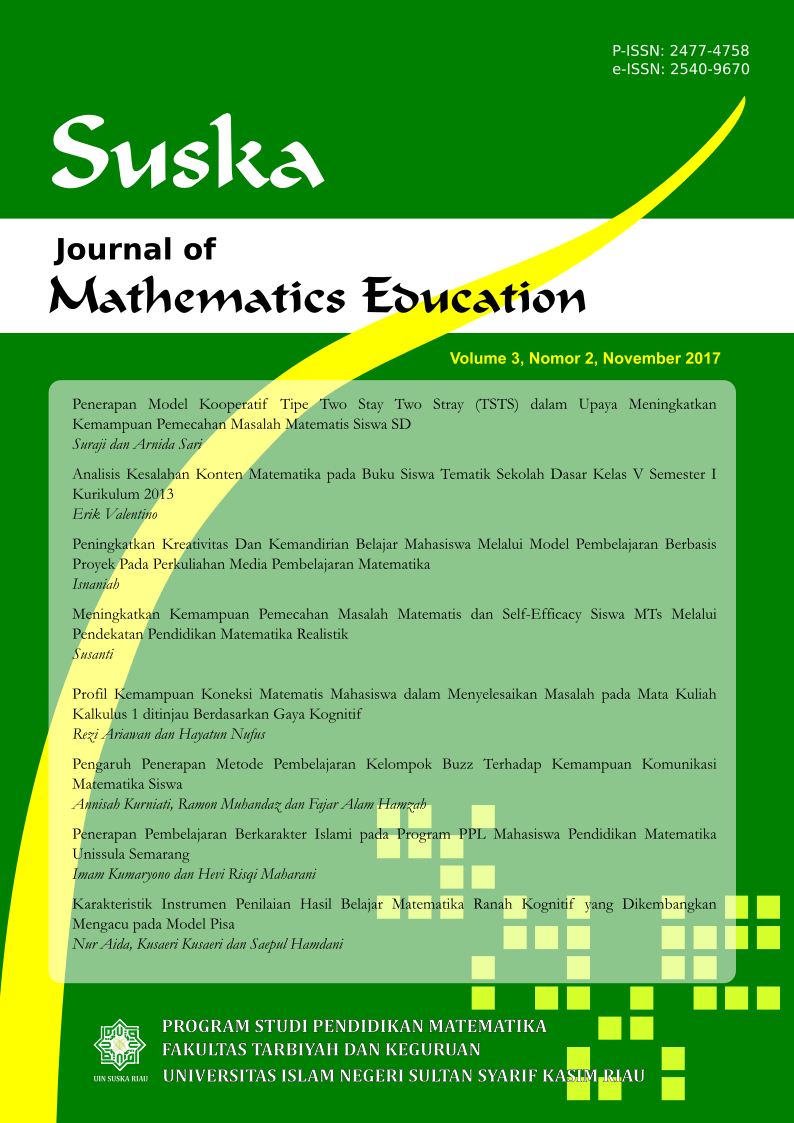Pengaruh Pembelajaran Pendekatan Humanistik Terhadap Kemampuan Pemecahan permasalahan Siswa
Abstract
Ketakutan dan kecamasan siswa dalam matematika merupakan sumber utama kegagalan mereka menguasai matematika yang berdampak dengan ketidakmampuan mereka menyelesaikan masalah yang memerlukan pemahaman, keseriusan, dan konsentrasi. Penelitian ini bertujuan untuk mengkaji pengaruh pembelajaran pendekatan humanistik terhadap kemampuan pemecahan perasalahan matematis siswa. Penelitian ini menggunakan metode eksperimen semu dengan rancangan Post-test Only Control Group. Populasinya adalah siswa MTs di Kota Pekanbaru, sedangkan sampelnya 60 siswa kelas VIII. Pengambilan sampel dengan menggunakan teknik purposive sampling. Instrumen yang digunakan dalam penelitian adalah tes berupa soal-soal pemecahan permasalahan matematis. Kesimpulan penelitian ini adalah terdapat pengaruh pembelajaran pendekatan humanistik terhadap kemampuan pemecahan permasalahan matematis siswa
Full Text:
PDFReferences
Carson, J. (2007). A problem with problem solving: Teaching Thinking Without Teaching Knowledge. The Mathematics Educator, 17(2), 7–14.
Fitria NFN, Nurul Hidayani, Heris Hendriana, R. A. (2018). Analisis Kemampuan Pemecahan Masalah Matematik Siswa SMP dengan Materi Segitiga dan Segiempat. Edumatica, 08(April), 49–57. https://online-journal.unja.ac.id/index.php/edumatica
Fried, M. (2004). Humanistic Mathematics As Mathematics for All. Humanistic Mathematics Network Journal, 1(27), 1–19. https://doi.org/10.5642/hmnj.200401.27.15
Haglund, R. (2004). Using Humanistic Content and Teaching Methods to Motivate Students and Counteract Negative Perceptions of Mathematics. Humanistic Mathematics Network Journal, 1(27).
Harskamp, E., & Suhre, C. (2007). Schoenfeld’s problem solving theory in a student controlled learning environment. In Computers and Education (Vol. 49, Issue 3, pp. 822–839). https://doi.org/10.1016/j.compedu.2005.11.024
Hoosain, E. (2004). What Are Mathematical Problems? Humanistic Mathematics Network Journal, 1(27), 1–8. https://doi.org/10.5642/hmnj.200401.27.12
John W. Creswell. (2012). Educational Research: Planning, Conducting, and Evaluating Quantitative and Qualitative Research (4th ed.). Boston: Pearson.
Kantowski, M. G. (1977). in Involved Processes Mathematical Problem. Journal for Research in Mathematics Education, 8(3), 163–180.
Kirkley, J. (2003). Principles for teaching problem solving. PLATO Learning, January 1998, 1–16. http://citeseerx.ist.psu.edu/viewdoc/download?doi=10.1.1.117.8503&rep=rep1&type=pdf
NCTM. (2000). Principles and Standards for School Mathematics. Library of Congress Cataloguing-in-Publication Data.
Nizam. (2016). Ringkasan Hasil-hasil Asesmen Belajar Dari Hasil UN, PISA, TIMSS.
Pratiwi, I. (2019). Efek Program Pisa Terhadap Kurikulum Di Indonesia. Jurnal Pendidikan Dan Kebudayaan, 4(1), 51. https://doi.org/10.24832/jpnk.v4i1.1157
Schoenfeld, A. H. (2013). Cognitive Science and Mathematics Education (1st ed.). Taylor and Francis.
Siswono, T. Y. E. (2018). Pembelajaran matematika: berbasis pengajuan dan pemecahan masalah (N. N. M. (ed.); Pertama). Remaja Rosdakarya.
Streun, A. Van. (2000). Representations in applying functions. International Journal of Mathematical Education in Science and Technology, 31(5), 703–725. https://doi.org/10.1080/002073900434387
Tennant, R. F. (2002). Interdisciplinary teaching strategies in the world of “humanistic mathematics.” Art and Science Electronic Journal, 4(4).
Wulandari, N. F., & Jailani. (2015). Me – 27 Indonesian Students ’ Mathematics Problem Solving Skill in Pisa and Timss. Indonesian Students’ Mathematics Problem Solving Skill in PISA and TIMSS, May, 17–19.
DOI: http://dx.doi.org/10.24014/juring.v4i4.15553
Refbacks
- There are currently no refbacks.
Juring (Journal for Research in Mathematics Learning)
Universitas Islam Negeri Sultan Syarif Kasim Riau
Indexed by:













